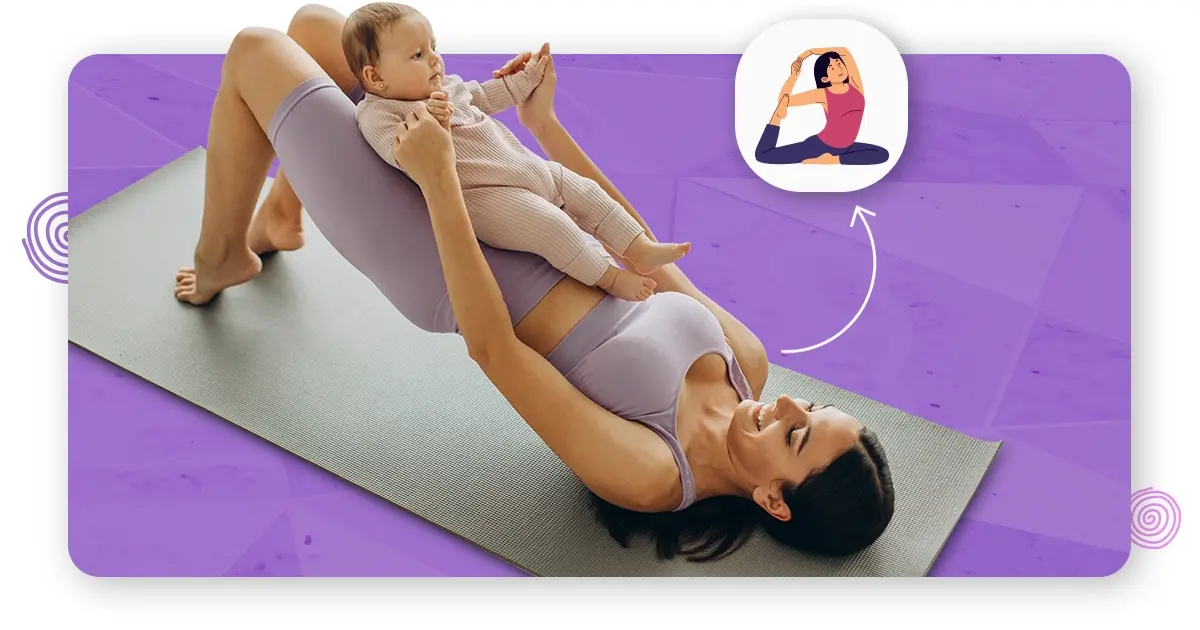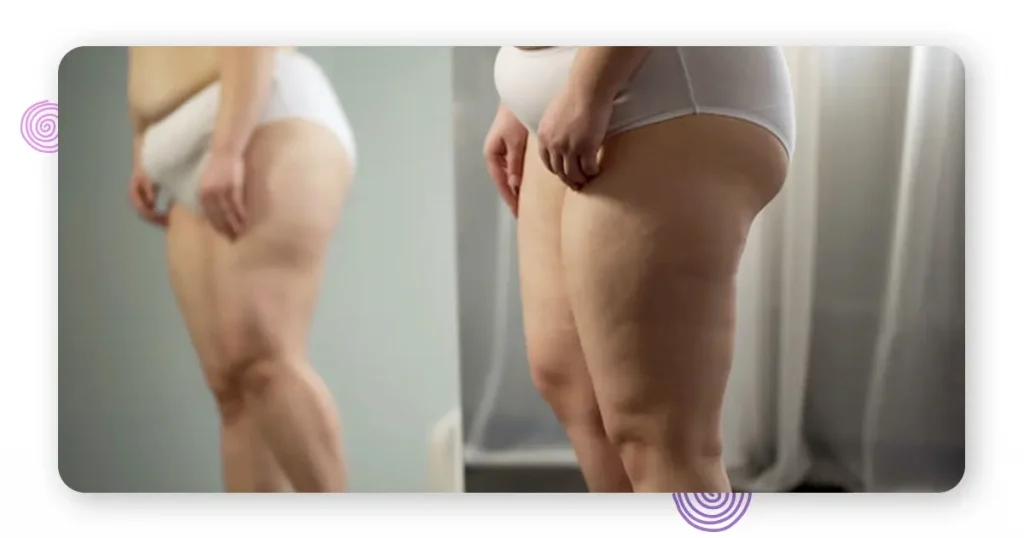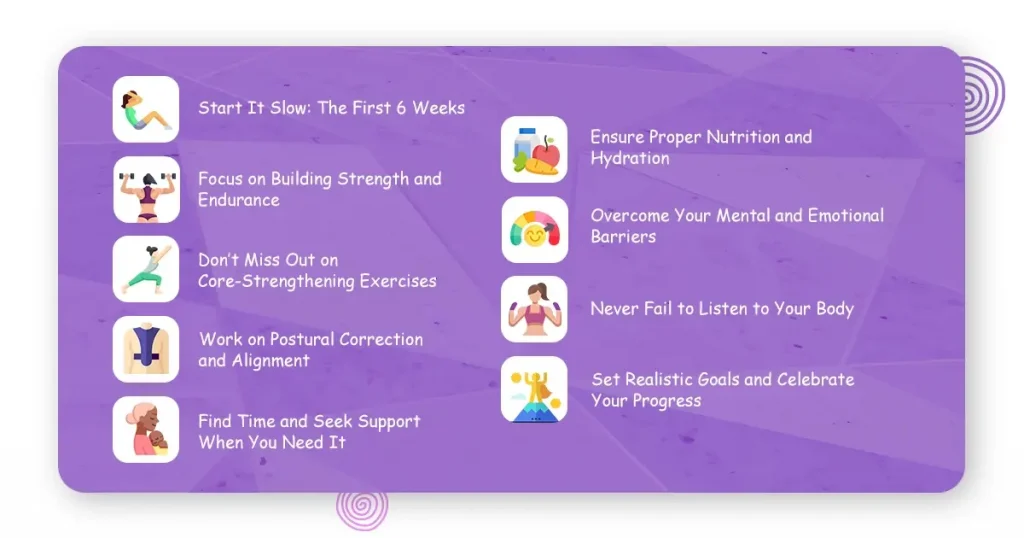Fitness After Pregnancy: 6 Months Postpartum Exercise Tips

Hello there! Now that you have your baby with you, you might be wondering how…
Hello there! Now that you have your baby with you, you might be wondering how soon you can get back to your old pre-pregnancy routine. And for some of you, it may include restarting your workouts as well. Whether you were a regular at the gym before pregnancy or someone who wants to build their fitness levels now that they have a tiny human to take care of, postpartum exercise is important for everyone. After all, it has several benefits we can’t ignore! So for all those new moms who are ready to sweat it out (and get back their strength and shape!), today we’re going to share a few 6 month postpartum exercise tips to help you meet your fitness goals after delivery.
Understanding the Postpartum Body

A woman’s postpartum body never feels the same as it did before getting pregnant. Pregnancy brings along many physical changes during those nine months when your body is busy growing your little one. You put on weight, your hips get wider, your breasts may sag due to fat accumulation, and your facial and abdominal skin may darken and stay that way. Plus, the center of mass of your body shifts forward, your back’s natural curve alters, and your posture changes all at the same time.
Then there are the hormonal adjustments that your body goes through after childbirth. Though it’s not the same for all women, hormones usually return to their pre-pregnancy state 6–8 weeks after delivery. But before that, you may be moody, sensitive, and irritable, and for some, it could lead to anxiety and postpartum depression. The effects of the hormone ‘relaxin’ also last for some time post-delivery. Your loosened joints and ligaments, especially in your pelvic region, are still flexible and supple, increasing the chances of injury if you resume rigorous activities.
All of these changes, along with sleep deprivation and the new challenges of breastfeeding and caring for your pumpkin, can leave you overworked and exhausted. You might feel out of shape and lonely doing the same things on repeat. So, you see how pregnancy and delivery can change your life altogether. But embracing the value of a healthy lifestyle and maintaining your fitness levels can help you get back to your pre-pregnancy self sooner.
Importance of Medical Clearance and Consultation

But before you put on your workout shoes and get started with your fitness routine, it is extremely important to see your doctor and get her approval. Whether you’re ready for it at 6 weeks or 6 months after delivery, you must receive your doctor’s green signal to go ahead with any kind of physical activity. She can access your current state, evaluate if you’re really ready for exercise, and consider your delivery-related factors before she gives her approval. You can also use this visit to express any specific concerns you might have regarding resuming exercise after your baby’s birth.
At this point, we would like to highlight that getting back to exercising after your baby’s arrival is not a race. Every woman should take her own time to decide if she’s ready. For some, it could be just a few days after their baby’s birth, and for others, it could be close to 6 months or more. Both are okay! Whatever your situation may be, just don’t forget to meet up with your doctor and tell her about your plans. She will be giving you some of the best advice.
Effective Tips for Your 6 Month Postpartum Exercise Journey

Start it Slow: The First 6 Weeks
Once you get your doctor’s clearance, you may be tempted to put your best foot forward so you can be fit and healthy. But remember! Trying to do too much too soon can do more harm than good. As your body is in a state of recovery, you must take it slowly, no matter when you start exercising. Progressing gradually towards your fitness goals is the best thing you can do for yourself at this time. Stressing yourself can slow down your recovery process, and you may take longer to reach your best health status.
To ease yourself into your new exercise routine without harming your body, it is better to start off with some gentle exercises like walking and stretching. For new moms, it is recommended that they do low- to moderate-intensity exercises for at least 150 minutes a week, i.e., 30 minutes for five days a week. Please note that you don’t have to get these 30 minutes of activity all at once. You can split it into three 10-minute sessions or six 5-minute sessions spread throughout the day. Whatever works best for you!
You can also perform some pelvic floor muscle exercises, which are one of the safest exercises for new moms. This set of simple exercises will strengthen your pelvic floor muscles and enhance your bladder control, so you won’t have to deal with problems like urine leakage and pelvic floor prolapse.
Focus on Building Strength and Endurance
Body muscles usually lose some of their strength during the postpartum period, when you are supposed to rest and take your time to heal and recover. Postpartum exercises are a great way to regain your lost strength. Therefore, you must include exercises that concentrate on building muscle strength. For example, you can do yoga twice a week along with aerobic exercises to improve your strength, balance, and flexibility. Or if you’re a person who loves weight training, you may do so with light weights. Some other exercise options to build your stamina after delivery are pilates and swimming.
If you are new to strength training and have never tried it before, your best bet would be to join one of those postnatal exercise classes offered around your neighborhood. Your trainer there will be able to guide you on how to proceed toward better health. What’s more! Many of them will allow you to bring your baby along, so you don’t have to worry about leaving him or her alone at home.
Don’t Miss Out on Core-Strengthening Exercises
Your core loses a lot of its strength after pregnancy and delivery. As your belly expands to create room for your growing fetus, your abdominal muscles stretch out while your back muscles shrink in size. Your right and left abdominal muscles could even separate and build a gap, which may take up to 8 weeks after your baby is born to get back to normal. Even your diaphragm and rib cage undergo some changes as your belly grows bigger.
These changes don’t automatically normalize after delivery. Plus, the uncompromisable sedentary lifestyle one has to live post-delivery further increases muscle weakness and stiffness. Thus, we can’t miss out on building a strong core that has the right tone and muscular strength. Some simple exercises that you can try are:
Work on Postural Correction and Alignment
The physical changes that support your body in bringing a new life into this world are known to affect your body alignment and steer you toward developing poor form. This happens because you unknowingly adopt new movement styles as your belly grows in size, and they stay with you for a long time unless you address the changes and work to correct your posture and alignment. A few exercises for improving your posture are:
If you have joined the gym or any postnatal classes, your trainer will likely spot if you have poor form or are performing movements incorrectly. But if you have decided to exercise at home, you should maintain good posture when carrying out your routine. When standing, make sure you have pulled in your abdominals, your shoulders are back, and your chin is drawn in a little. Also, pay attention to focusing on calm breathing. If you find yourself holding your breath, you’re probably exerting yourself too much.
Find Time and Seek Support When You Need It
Balancing childcare and exercise can seem like an impossible task. But taking some time out for yourself will help you in the long run and equip you better to care for your baby. Ask your partner to look after the baby for some time. Or if you have family and friends close by, don’t hesitate to ask for help. Anyway, you don’t need a lot of time to get fit.
If you can find someone who can watch your baby for a short duration of 20–30 minutes a day, you’ll be all set. If nothing works and you want to prioritize your health (which you should!), you can explore postnatal fitness programs and join one of those where you can bring your baby along.
Ensure Proper Nutrition and Hydration
Eating well is important not just during pregnancy but after delivery, too. More so if you are breastfeeding your little one. Consuming a well-balanced diet keeps your energy levels high and also supports your postpartum weight loss journey. Include recommended amounts of protein, healthy fats, fruits, veggies, and whole grains in your diet.
You may consult a nutritionist if you want proper guidance on meeting your nutritional requirements after delivery. In addition to eating a healthy diet, don’t neglect your water intake. You may feel thirstier than usual if you’re breastfeeding. So, hydrate yourself before you begin exercising, keep your water bottle by your side, and sip on it frequently in between exercises.
Overcome Your Mental and Emotional Barriers
Post-delivery, you may have to deal with mental and emotional issues as well. Your changing hormones are to blame here as well. Sadly, many women also develop body image issues after delivery. If you ever find yourself in the same boat, remember what your body is capable of and how it has brought a beautiful new member to your family. Your body has done a lot during the past nine months, and it deserves all the love, attention, and appreciation in the world.
Seek professional support if you have anxiety or whenever you find yourself so stressed that it starts affecting your mental well-being. Postpartum depression can also make your life difficult if left unattended. So reach out to your provider if you doubt you’re being affected by it. Besides professional help, keep your exercise routine going. Exercise can elevate your mood and even curb the symptoms of postpartum depression.
Never Fail to Listen to Your Body
While it is important that you exercise regularly after you get the go-ahead from your provider, don’t neglect any warning signs that tell you to stop. When working out, if you experience pain or discomfort, stop exercising then and there. And only resume once you share it with your doctor and she says it’s okay to continue.
As every person has their own limits, try not to push yourself if an exercise wears you out too soon or seems difficult. You may modify your exercises, for example, by trying a low-impact version if that’s all you can handle at the moment. Rest assured, you will be able to do more soon if you take it slowly and gradually.
Also, see to it that you have planned enough recovery days during the week to rest and relax. Fatigue can significantly dampen your enthusiasm to stay active. So, rest whenever you need so you can show up the next time.
Set Realistic Goals and Celebrate Your Progress
Begin your postpartum fitness journey by setting realistic goals. Consider how much time you can pull out in a day for exercise, what your present energy levels are, how tired you feel, and so on. Depending on these factors, set your goals. They don’t have to be too elaborate at the beginning. Start with whatever you can do and take it forward. Even a 5-minute walk can add up to your daily fitness goals.
It also helps to track your journey to know how far you have come. Seeing or feeling the difference can motivate you to continue and never stop. And lastly, acknowledge the fact that your body is healing and will need its own time to recover. Try not to compare your fitness journey with others. Embrace your own, and you will soon be rewarded with good physical and mental health.
Final Word
It is understandable that new moms have a lot on their plates and are super busy looking after their babies. For many of you, tiredness and sleepless nights are unavoidable, and exercising may be the last thing on your mind. But at this time, prioritizing your health is equally important. By maintaining a healthy lifestyle after delivery and beyond, you will be better prepared to face the challenges of motherhood and enjoy your new life as a mom more than ever!
FAQs
Postpartum exercise has not one but many health benefits. Regular, gentle exercise helps you recover from the stress your body has gone through during labor and delivery. It strengthens your muscles, boosts your energy levels, and promotes postnatal weight loss. It even elevates your mood and keeps you away from postpartum depression.
Postpartum pain and discomfort can stay with you for several days after delivery, depending on how you delivered and if there were any complications. If you experience any pain or uneasiness during exercise, know that it’s time to stop. Having any sort of pain when exercising means your body is not yet ready for it.
Make sure you take these precautions every time you exercise:
1. Take it slow and practice gentle exercise.
2. Begin with a warm-up routine and finish off with some cool-down exercises.
3. See that you maintain proper posture during exercise.
4. Have a sip of water in between exercises to stay hydrated.
5. Stay away from exercises that require rapid twisting and turning or those involving jerky movements.
6. Stop immediately the moment you feel any pain or discomfort.
If you have had a normal delivery with no complications, you may be ready to exercise a few days after your delivery. However, if you had to undergo a c-section or there were complications, you will have to wait at least until your 6-week postnatal checkup. In both cases, before you start your postpartum workout regimen, your doctor’s approval is necessary.

